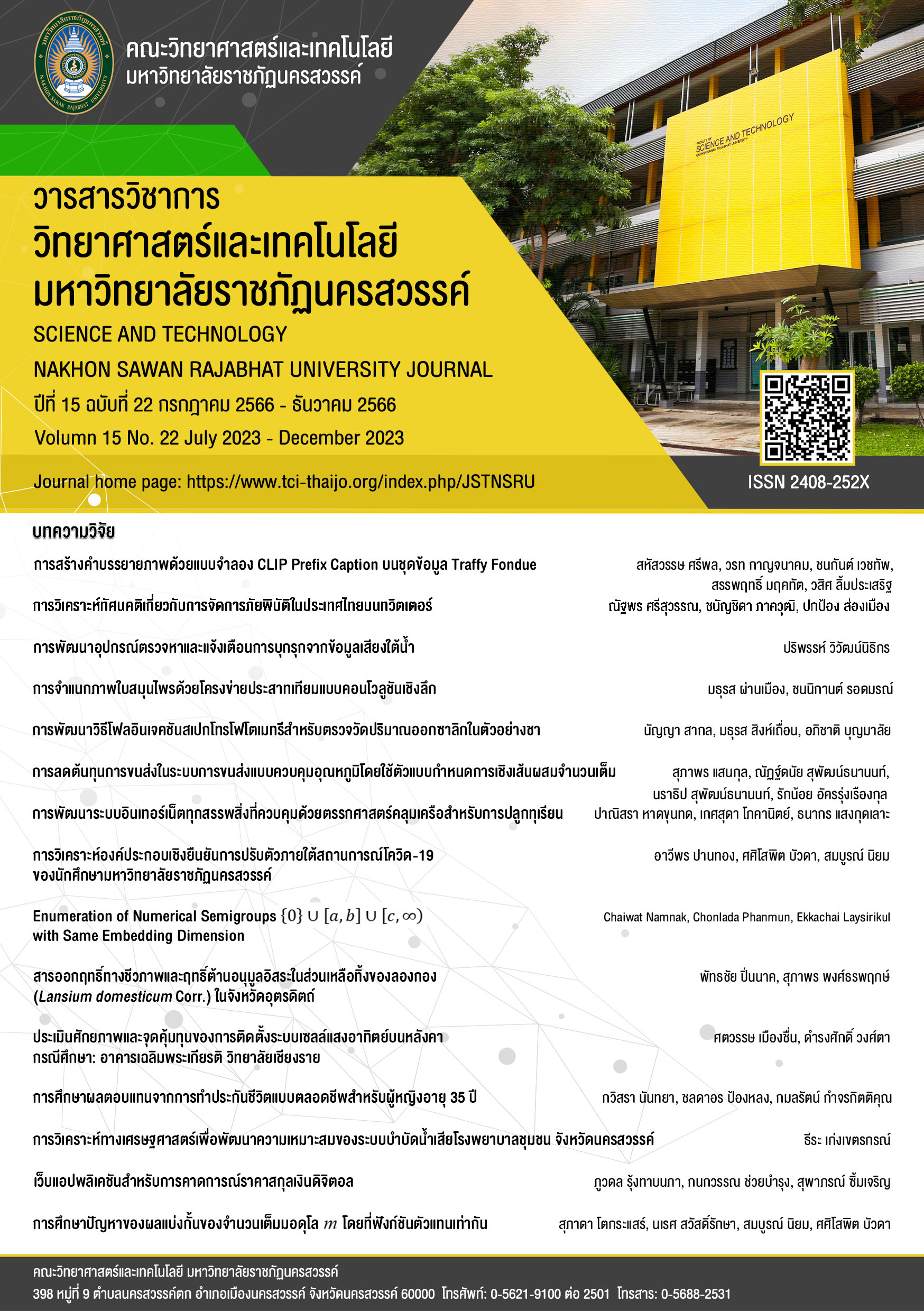การวิเคราะห์ทางเศรษฐศาสตร์เพื่อพัฒนาความเหมาะสมของระบบบำบัดน้ำเสียโรงพยาบาลชุมชน จังหวัดนครสวรรค์
Keywords:
Unit Cost, Optimal, Cummunity Hospital Wastewater Treatment PlantAbstract
การศึกษานี้เป็นการวิเคราะห์ต้นทุนต่อหน่วยและความเป็นไปได้ในการพัฒนาความเหมาะสมของระบบบำบัดน้ำเสียของโรงพยาบาลชุมชนในจังหวัดนครสวรรค์ สร้างรูปแบบการควบคุมและพัฒนาการดำเนินระบบบำบัดน้ำเสียต้นแบบ ผลที่ได้จากการศึกษาสามารถใช้เป็นแนวทางการตัดสินใจเลือกระบบบำบัดน้ำเสียของโรงพยาบาลชุมชนได้อย่างเหมาะสม คุ้มค่า มีประสิทธิภาพ ไม่ก่อให้เกิดผลกระทบต่อสุขภาพและสิ่งแวดล้อม โดยศึกษาการวิเคราะห์ภาระบรรทุกสารอินทรีย์ แนวโน้มขีดจำกัด และวิเคราะห์ทางเศรษฐศาสตร์ของระบบบำบัดน้ำเสียที่กระทรวงสาธารณสุขกำหนด ได้แก่ ระบบสระเติมอากาศ ระบบคลองวนเวียน และระบบตะกอนเร่ง ผลการศึกษาพบว่า ระบบบำบัดน้ำเสียเดิมที่เป็นระบบบ่อบำบัดน้ำเสียทุกแห่งมีค่าภาระบรรทุกสารอินทรีย์สูงกว่าค่ามาตรฐานคือมากกว่า 12 กรัมบีโอดีต่อตารางเมตรต่อวัน และมีค่าสูงสุดเฉลี่ย 84 กรัมบีโอดีต่อตารางเมตรต่อวัน ที่โรงพยาบาลตาคลี ค่าเฉลี่ยต้นทุนต่อหน่วยของระบบบำบัดน้ำเสียที่ระยะเวลา 20 ปี ของระบบ สระเติมอากาศมีค่าต่ำที่สุด 34 บาทต่อลูกบาศก์เมตร ในขณะที่ระบบตะกอนเร่งมีค่าเฉลี่ยต้นทุนต่อหน่วยสูงที่สุด 54 บาทต่อลูกบาศก์เมตร เมื่อพิจารณาความเป็นไปได้ตามข้อจำกัดของพื้นที่ เทคโนโลยีที่เหมาะสม และประสิทธิภาพ ร่วมกับต้นทุนต่อหน่วย จะพบว่าระบบคลองวนเวียนมีความเหมาะสมที่สุดและเมื่อนำมาเป็นระบบบำบัดน้ำเสียต้นแบบพัฒนาความเหมาะสมด้วยรูปแบบตามแนวคิด 3 พี ที่มีกระบวนการกำหนดเป้าหมาย กระบวนการดำเนินงาน และผลลัพธ์ที่ต้องการ สามารถควบคุมดูแลระบบบำบัดน้ำเสียของโรงพยาบาลให้มีประสิทธิภาพการลดค่าบีโอดีสูงถึงร้อยละ 95.8 ค่าภาระบรรทุกสารอินทรีย์ไม่เกินค่ามาตรฐาน ไม่ก่อให้เกิดผลกระทบต่อสุขภาพและสิ่งแวดล้อม
References
กองบริหารการสาธารณสุข สำนักงานปลัดกระทรวงสาธารณสุข. (2565). แนวทางการของบประมาณระบบบำบัดน้ำเสียโดยใช้แบบแปลนมาตรฐานของสำนักงานปลัดกระทรวงสาธารณสุข. กระทรวงสาธารณสุข.https://phdb.moph.go.th
เกรียงศักดิ์ อุดมสินโรจน์. (2539). การบำบัดน้ำเสีย (Wastewater Treatment). มิตรนราการพิมพ์: กรุงเทพมหานคร.
สมาน รุ่งศรีทอง. (2542). ความเหมาะสมของภาระบรรทุกสารอินทรีย์ของระบบบำบัดน้ำเสียโรงพยาบาลชุมชน จังหวัดนครสวรรค์. สำนักงานสาธารณสุขจังหวัดนครสวรรค์.
Bhandari, G., Chaudhary, P., Gangola, S., Gupta, S., Gupta, A., Rafatullah, M., & Chen, S. (2023). A review on hospital wastewater treatment technology: Current management practices and future prospects. Journal of Water Process Engineering, 56, 1-6. https://doi.org/10.1016/j.jwpe.2023.104516
Carraro, E., Bonetta, S., Bertono, C., Lorenzi, E., & Gilli, G. (2016). Hospital effluents management: chemical, physical, mocrobiological risks and legislation in different countries. Journal Environmental Management, 168, 185-199. https://doi.org/10.1016/j.jenvman.2015.11.021
Cetkovic, J., Knezevic, M., Lakic, S., Zarkovic, M., Vujadinovic, R., Zivkovic, A., & Cvijovic, J. (2022). Financial and Economic Investment Evaluation of Wastewater Treatment Plant, Water, 14(122), 1-23. https://doi.org/10.3390/w14010122
Chartier, Y. (2014). Safe Management of Wastes from Health-care Activities. World Health Organization. https://www.who.int/publications/i/item/9789241548564
Cicekalan, B., Kosar, S., Cingoz, S., Eyit, N., Ersahin, M.E., & Ozgun, H. (2023). Techno-economic and environmental assessment of different municipal wastewater treatment systems. Journal of Water Process Engineering, 53, 1-6. https://doi.org/10.1016/j.jwpe.2023.103822
Danchaivijitr, S., Wongchanapai, W., Assansen, S., & Jintanothaitavorn, D. (2005). Microbial and Heavy Metal Contamination of Treated Hospital Wastewater in Thailand. Journal Medical Association Thailand, 88, s59-s64. https://www.researchgate.net/publication/6934525
Goffi, A.S., Trojan, F., Lima, J.D., Lizot, M., & Thesari, S.S. (2018). Economic feasibility for selecting wastewater treatment systems. Water Science & Technology, 48(12), 2518-2531. https://doi.org/10.2166/wst.2019.012.
Kumari, A., Maurya, N.S., & Tiwari, B. (2020). Hospital Wastewater Treatment Scenario Around the Globe. Current Developments in Biotechnology and Bioengineering, 549-570 https://doi.org/10.1016/B978-0-12-819722-6.00015-8
Majumder, A., Gupta, A.K., Ghosal, P.S., & Verma, M. (2020). A review on hospital wastewater treatment: A special emphasis on occurrence and removal of pharmaceutically active compounds, resistance microorganisms and SARA-CoV-2. Journal of Environmental Chemical Engineering, 9, 1-20. https://doi.org/10.1016/j.jece.2020.104812
Pradeepreddy, P., & Rajesh, K. (2019). Hospital Wastewater Treatment. Journal of Engineering Sciences, 10(9), 191-195. https://doi.org/10.15433.JES.2019.V10I9.43P.35
Preecha, U., Sridang, P., & Wanichapichart, P. (2009). Preliminary Study of Hospital Wastewater Treatment with a Submerged Membrane Bioreactor (SMBR): Case Study of Songklanagarind Hospital-Thailand. Journal of Applied Membrane Science & Technology, 9(1), 9-17. https://doi.org/10.11113/amst.v9i1.64
Senante, M.M., Sancho, F.H., & Garrido, R.S. (2012). Economic feasibility study for new technological alternatives in wastewater treatment processes: a review. Water Science & Technology, 65(5), 898-906. https://doi.org/10.2166/wst.2012.936.
Verlicchi, P., Aukidy, M.A., & Zambello, E. (2015). What have we learned from worldwide experience on the management and treatment of hospital effluent?-An Overview and a discussion on perspectives. Science of the Total Environment, 514, 467-491. https://doi.org/10.1016/j.scitotenv.2015.02.020
Zhang, X., Yan, S., Chen, J., Tyagi, R.D., & Li, J. (2020). Physical, chemical, and biological impact (hazard) of hospital wastewater on environment: presence of pharmaceuticals, pathogens, and antibiotic-resistance genes. Current Developments in Biotechnology and Bioengineering, 3, 79-102. https://doi.org/10.1016/B978-0-12-819722-6.00003-1
Downloads
Published
Issue
Section
License
Copyright (c) 2023 SCIENCE AND TECHNOLOGY NAKHON SAWAN RAJABHAT UNIVERSITY JOURNAL

This work is licensed under a Creative Commons Attribution-NonCommercial-NoDerivatives 4.0 International License.



